Tony Boyer's book, The Book of Rifle Accuracy(which I read to learn from), page 149, describes how to read various shapes/forms of carbon deposits on the necks of 3-5 times fired cases to help determine if the case neck is too thick. On page 149, figure "1" shows a carbon ring all around the entire case neck (about one-third of the way down from the case mouth to the case shoulder-neck junction) which Tony indicates means the case neck is too thick (has not been turned enough). On this same page, figure "2" shows a drawing of a case showing carbon coming down from the case mouth to the case shoulder-neck junction on only part of the case (not all around the circumference of the case); I am not sure what Tony is saying here in this figure "2" - I do not understand what this drawing is trying to show and tell us. Anyone know?
Also, this section of the book addresses such carbon deposits only as a way to determine if the neck is too thick. Anyone know how to read such carbon deposits to determine if the case necks are too thin?
Are you using similar components ? Flat base bullets , stiff loads , etc .
Ggmac - no, I'm not using the 6 PPC that I think Tony is addressing in his book, I'm using 6.5x47 mm Lapua with boattail bullets. Havnt got the optimal powder load identified yet, but think it will be at the node toward the upper end of load range that gives me load room on either side, if feasible.
What I believe Tony is referring to in his book is a sine wave looking carbon line on the neck of the brass. What that shows is that you have enough clearance between the neck and the chamber. What the sine wave shows us is that some of the gases escape into the chamber before the neck actually expands completely, sealing the chamber. This proves that you are getting a good bullet release.
It's my opinion that this general rule applies to all cartridge/component combinations. Please correct me if I'm wrong.
I think data would be different when using boatail bullets , the pressure ring of flat base are not present . Which in experience has given different gas ,blowback carbon deposits . I think case neck dimensions would be different if using boatail again because of the pressure ring .
I know I read something about this in Precision Shooting .
Anyone else ?
Gary
GPat said:
What I believe Tony is referring to in his book is a sine wave looking carbon line on the neck of the brass. What that shows is that you have enough clearance between the neck and the chamber. What the sine wave shows us is that some of the gases escape into the chamber before the neck actually expands completely, sealing the chamber. This proves that you are getting a good bullet release.
It's my opinion that this general rule applies to all cartridge/component combinations. Please correct me if I'm wrong.
I would agree it should be applicable to any cartridge.
In my experience with a ppc with a 262 neck I started out looking for .001 total clearance. I thought the closer the fir the better and a lot of guys are successful with that approach. With my cases fitted this way the carbon ring was a solid line all the way around the neck just a few thousands back from the edge of the neck.
After watching Jack Neary talk about brass prep for a ppc. I tried his approach looking for .0015 clearance on both sides of the neck or .003 total clearance. This approach for me has improved my over all group aggs. It also shows the wave type carbon pattern on the necks.
I would think in a SAMMI chambered barrel and in my experience with a no turn 6br in a sammi chamber there is quite a bit more clearance around the neck than .003 I use in the ppc. My 6 BR shows a solid carbon line around the necks down closer to the shoulder
I shoot barts 68gr BT as well as 66gr flat base bullets. In my rifle the wave type pattern appears with both
for what it's worth
Thanks . We're the Bts the same diam as the FB pressure ring ?
Ggmac said:
Thanks . We're the Bts the same diam as the FB pressure ring ?
Just miced a couple. The 68gr bt measures .243 the 66gr FB are .2435
Best I can tell.
Cassidy, reloading 101 would have you measure your necks. Probably in plenty of books.
mikecr - I measure my necks and can turn them to whatever target thickness I select (to about +/- 0.0001-2). The question I am trying to resolve is how do I find/select the correct target case neck thickness for my case (6.5x47 L) and for my rifle (reamer) chamber. Based on my read, Tony's book (p 149) suggests that the residual carbon pattern can help determine the appropriate target case neck thickness. I am trying to understand what Tony is trying to describe for the reader in his description of figure "2" (in my original post) which he describes as "neck not too thick", meaning if the carbon pattern on the case neck looks like figure "2", the case neck is not too thick. If I can figure out what this pattern looks like that he trying to describe (I can't figure out what the drawing in figure 2 is trying to show), I can test several different case neck thicknesses (fire each of maybe 4-5 cases 3-4 times at each test neck thickness) and that way maybe find out which neck thickness might be most optimal (best group) for my particular 6.5x47 case for my particular chamber. It may be just one more way to tune the case.
Separately, what is not described in the book is how to determine - what to look for (what kind of carbon pattern) - if the neck thickness is too thin.
fig2 in the book is an illustration of the carbon wave type pattern that is left on the necks. That appears when some think (Mr Boyer being one) the neck clearance is the ideal amount of clearance for the best accuracy and consistent bullet release.
It sounds from your post that you are getting that from reading his book. as I was saying earlier not enough clearce leaves a carbon line all the way around the neck as Tony illustrates in fig1
Do you have a reamer print for your chamber?
If not you will have to cast it and measure the neck area to know where to start.
If it is a SAMMI chamber you will have to much clearance and IMO will not ever see the sine wave pattern. An abundance of clearance results in a solid ring around the neck that will extend further down closer to the shoulder
With the resolution it's really hard to see the wave but here is a pic
-

image.jpg
59.5 KB
· Views: 277
-

image.jpg
134.8 KB
· Views: 282
Most guys shooting a tight neck rifle know what the neck is supposed to be. The actual dimension will vary from chamber to chamber even using the same reamer
In my case it is a .262 neck so I at least know where to start. I target a loaded round to measure .259 giving me a total of .003 clearance with this I get a clear sine wave type carbon powder pattern. If I load tighter than that it goes away and I get a solid line. If load looser than that I get a solid line just further down
I don't know if I'm helping or not?
Tim - that helps! It may be that Tony was trying to depict a sine wave in his Figure "2". As Tony described on page 149, the up and down (apex and nadir) of the sine wave may be around the lugs relative to the position in the chamber of the case.
Tim - that explains a lot! I have a drawing of the reamer, but I think the neck reamer diameter and therefore the chamber neck diameter may be a few thou too large. This is why I am only truing the necks (bringing them all to about 0.0124") thickness just to make them all the same thickness all around their circumference. This will leave maybe 0.0037" (maybe a touch more) total clearance between the case neck and the chamber neck, which I think is too much, meaning I will probably have to get another barrel and reamer with a smaller/tighter neck dimension. This also means I am not sure I will be able to see the sine wave carbon pattern at optimal case neck thickness with the barrel I currently have. Can email the reamer drawing to you if you wish.
I would definitely see how it goes. I would imagine it will shoot great.
I assume you are shooting long rage? I would think reading wind conditions at longer ranges will have more of an impact than the neck clearance.
Do you plan to compete?
Tim - I've been and am continuing for some time to work through the seeming multitude of factors to get my brass and bullets ready/tuned, as well as balance the rifle (presently too front heavy on the front stand and rear bag (adding enough weight to the stock butt will put the total rifle weight >17 lbs)). Now addressing these matters, will then tune the rifle at 100 yds to get the proper powder load and seating depth, in prep for shooting at 1000 yds. Somewhere in all this will figure out the optimal neck thickness. That's the plan; it's taking a long time. Basically, I have been and am now putting together (trying to figure out) a case and bullet prep protocol/checklist to be sure I don't screw up each batch. Then will need to figure out where to shoot competitively once I know it/I can shoot.
I was gonna post a question about this very thing: brand new Lapua 6.5x284 brass that, during prepping, only 40% ~ 60% of the necked was actually turned and after first firing, the sine wave of carbon goes back and forth as you spin the cartridge from the neck/shoulder to almost the mouth of the case.
Perhaps I should 'skim' the rest of the batch a little more?
louielouie said:
I was gonna post a question about this very thing: brand new Lapua 6.5x284 brass that, during prepping, only 40% ~ 60% of the necked was actually turned and after first firing, the sine wave of carbon goes back and forth as you spin the cartridge from the neck/shoulder to almost the mouth of the case.
Perhaps I should 'skim' the rest of the batch a little more?
If a bullet will slip into a fired unsized case without resistance. And you have the sine wave type pattern. In my experience you are right where you need to be. Don't turn anymore. The pattern you see is what you want
If a bullet will not slip into the neck of a fired unsized case then the neck to chamber fit is to tight. Turn off another .0005 reload fire and re check
This is what has worked for me. Others may have different results
+1 on the sine wave for the soot. Louie, you've got the right turn regardless of 60%
Don't really know about the bullet slipping in the fired case. Mine don't always for my PPC and I KNOW I've got clearance aplenty. Seems like they've always slipped on the larger caliber stuff though.
Pat












